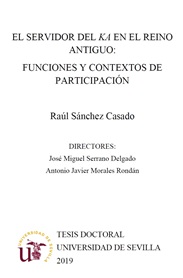| Main » Ad Board » ДРЕВЕН ЕГИПЕТ И АФРИКА » Религия и философия |
Raúl Sánchez Casado - El servidor del ka en el Reino Antiguo
| 16.10.2020, 15:45 | |
"Служителят на ка (душата)" на починалия е обикновено член на семейството или домакинството на лице, непринадлежащо към царската фамилия. Той се грижи за извършване на общоприетите ритуали и осигуряването на необходимите за тях продукти и консумативи. Египтяните от онази епоха вярват, че по този начин се гарантира благополучието на техния починал роднина в отвъдното. На фигурата на този служител, неговия социален статус и функции е посветена и настоящата испаноезична дисертация от университета в Севиля.
АЛТЕРНАТИВЕН ЛИНК / ALTERNATIVE LINK: - на испански език, от idUS - Depósito de Investigación de la Universidad de Sevilla, формат PDF.Свалянето става с десен бутон (downloading by right button) и Save as...АЛТЕРНАТИВЕН ЛИНК / ALTERNATIVE LINK: - на испански език, от CORE, формат PDF.Свалянето става с десен бутон (downloading by right button) и Save as...АЛТЕРНАТИВЕН ЛИНК / ALTERNATIVE LINK: - на испански език, от Google Drive, формат PDF. Сваляне с ляв бутон (downloading by left button) от страницата на предоставящия сървър, после през бутона стрелка надолу/after by down arrow button.
| |
| Views: 684 | Placed till: 16.11.2020 | Rating: 0.0/0 | |

